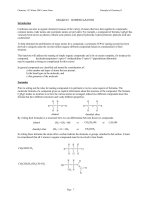Principles of communications
Bạn đang xem bản rút gọn của tài liệu. Xem và tải ngay bản đầy đủ của tài liệu tại đây (201 KB, 13 trang )
Principles of Communications
By: Vinh Dang Quang
Course information
Lecturer: Msc. Dang Quang Vinh
Mail:
Mobile:0983692806
Duration:30 hrs
Outline
Basic concepts
Information
Entropy
Joint and Conditional Entropy
Channel Representations
Channel Capacity
Basic concepts
What is Information Theory?
Information Theory: how much information
… is contained in a signal?
… can a system generate?
… can a channel transmit?
Used in many fields: Communications, Computer
Science, Economics,…
Examples: Barcelona 0-3 SLNA
Information
Let xj be an event with p(xj)
If xj occurred, we have
1
I ( x j ) = log a
= − log a p( x j )
p( x j )
units of information
The base of the logarithm
10 →the measure of information is hartley
e →the measure of information is nat
2 →the measure of information is bit
Examples 10.1 (page 669)
Entropy
H(X) = - ∑ p(x) log p(x)
Entropy = information = uncertainty
If a signal is completely predictable, it has
zero entropy and no information
Entropy = average number of bits required to
transmit the signal
Entropy example 1
Random variable with uniform distribution
over 32 outcomes
H(X) = - ∑ 1/32 log 1/32 = log 32 = 5
# bits required = log 32 = 5 bits!
Therefore H(X) = number of bits required to
represent a random event
How many bits are needed for:
Outcome of a coin toss
“tomorrow is a Wednesday”
US tops Winter Olympics tally”
Entropy example 2
Horse race with 8 horses, with winning
probabilities
½, ¼, 1/8, 1/16, 1/64, 1/64, 1/64, 1/64
Entropy H(X) = 2 bits
How many bits do we need?
(a) Index each horse log8 = 3 bits
(b) Assign shorter codes to horses with higher
probability:
0, 10, 110, 1110, 111100, 111101, 111110,
111111
average description length = 2 bits!
Entropy
Need at least H(X) bits to represent X
H(X) is a lower bound on the required
descriptor length
Entropy = uncertainty of a random variable
Joint and conditional entropy
Joint entropy:
H(X,Y) = ∑x ∑y p(x,y) log p(x,y)
simple extension of entropy to 2 RVs
Conditional Entropy:
H(Y|X) = ∑x p(x) H(Y|X=x)
= ∑x ∑y p(x,y) log p(y|x)
“What is uncertainty of Y if X is known?”
Easy to verify:
If X, Y independent, then H(Y|X) = H(Y)
If Y = X, then H(Y|X) = 0
H(Y|X) = extra information between X & Y
Fact: H(X,Y) = H(X) + H(Y|X)
Mutual Information
I(X;Y) = H(X) – H(X|Y)
= reduction of uncertainty due to another variable
I(X;Y) = ∑x ∑y p(x,y) log p(x,y)/{p(x)p(y)}
“How much information about Y is contained
in X?”
If X,Y independent, then I(X;Y) = 0
If X,Y are same, then I(X;Y) = H(X) = H(Y)
Symmetric and non-negative
Mutual Information
Relationship between
entropy, joint and
mutual information
Mutual Information
I(X;Y) is a great measure of similarity
between X and Y
Widely used in image/signal processing
Medical imaging example:
MI based image registration
Why? MI is insensitive to gain and bias









